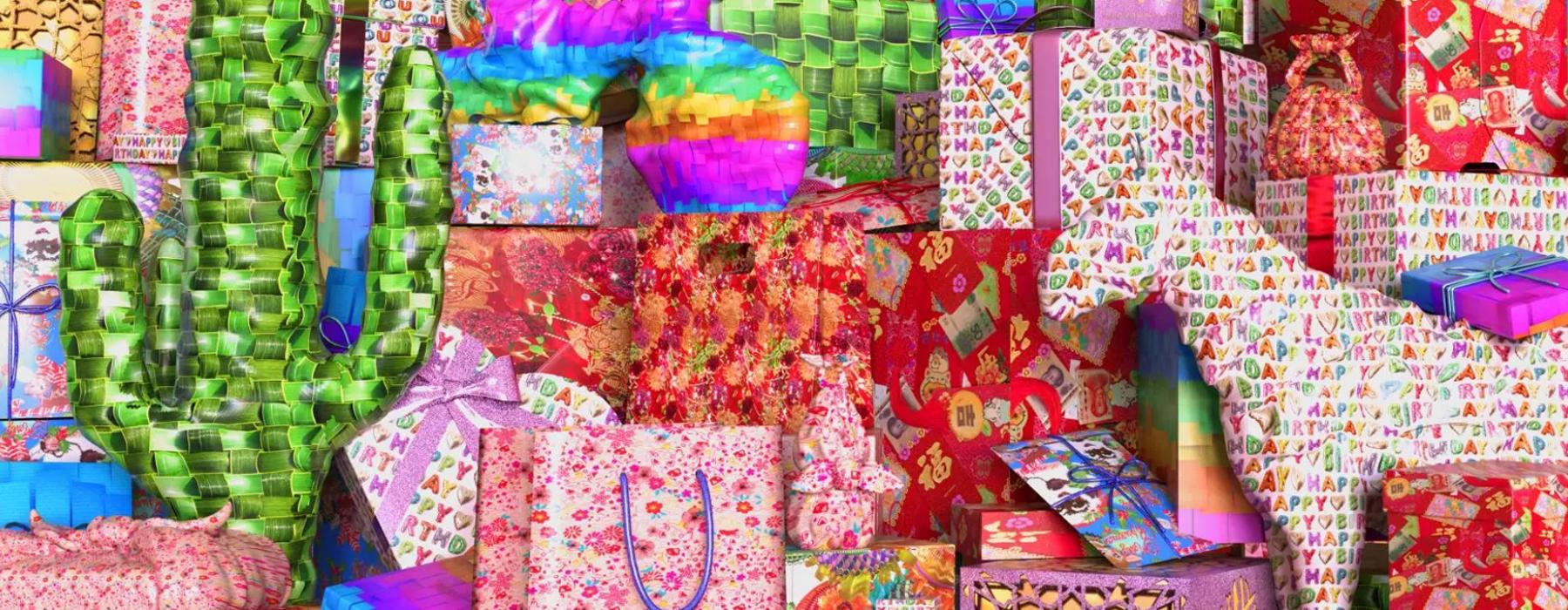
1. A little bit of holiness to take home
These are souvenirs from Christian holy places. The set of prayer beads, or rosary, is from Jerusalem.
The flag has a picture of the Holy Virgin of Guadeloupe. She is the most important saint in Mexico.
The words ‘Bless you my son’ are also on the flag. Some people who go to holy places bring back gifts
for the people at home.
1A Mexico City, Mexico; 1980-1990; cotton and wood; TM-5290-225
1B Jerusalem; around 1894; wood and metal; WM-4883
2. Magic dish
This dish is probably a souvenir that an Indonesian pilgrim (a person who visits a holy place) bought
in Mecca, a holy place for Muslims. The dish is decorated with Arabic writing. Some people believed
that if you put water in the dish the words written on it would give the water the power to heal and
protect.
Saudi Arabia; 1800-1916; brass; TM-29-68
3. Holy ground
This is a prayer stone. People place it on the ground in front of them while they pray and touch their forehead to it. The stone is made of clay from the holy city of Karbala, so it is a way of giving holy ground to another believer. The writing in Arabic says ‘gift from Karbala’. You can also see the grave of Hussain, grandson of the prophet Mohammed. The grave is an important place for Shi’ite Muslims, who believe that the descendants of the prophet, his family, should lead Muslims.
Karbala, Iraq; 1900-1950; earthenware; RV-B106-70
4. The Mecca of souvenirs
This little bottle of Zamzam water and the smartphone case are souvenirs from Mecca. Mecca is a
holy place for Muslims. When they go there on a pilgrimage they often buy gifts to give to people
back home. On the phone case there is a picture of the Kaaba, a very holy building in the centre of
the Great Mosque in Mecca. The water comes from the holy Zamzam Well.
4A Mecca, Saudi Arabia and Jakarta, Indonesia; around 2013; plastic, paper, water; RV-6202-3
4B Jedda, Saudi Arabia; 2000-2015; plastic; 7070-50, purchased with the help of the Mondriaan Fund
5. A clever doll
For Muslims it is important to go on a pilgrimage to Mecca at least once in their life. And of course if
you go on a trip like that, you want to take souvenirs home with you. Then you can give them to the
people who stayed at home. Sometimes people take dolls back with them. This one is called Rahmah.
If you squeeze her left hand she says words from the Koran.
Mecca, Saudi Arabia; 2000-2016; textile, metal; 7071-69
6. Safe for another year
At shrines in Japan you can often buy all kinds of amulets, which protect the person who carries
them, from road accidents for instance. Or they might help you pass your exams. People usually buy
an amulet for themselves, but you can also give one to a friend who needs help.
Japan; rond 2017; wood, ink, textile, paper, plastic
7. Gifts and prayers
Katsinam are supernatural messengers who live among the Hopi people in Arizona in the United
States each year. They come after the shortest day and stay for six months of dances and
ceremonies. During these ceremonies, the Katsinam give special carved dolls, which look like them,
to Hopi girls. In this way girls learn important stories about Hopi culture.
7A White clown figure and man: Hopi; Arizona, United States; around 1920; root, pigments; RV-2043-58
7B Aholi Katsina doll by Manfred Susunkewa (1940- ); Hopi; Arizona, United States; around 1990; root, feathers, textile, pigments; RV-5723-3
7C Navajo dancer Katsina doll: Hopi; New Mexico, United States; around 2000; root, pigments; RV6135-2
8. Now you are a full member
These gifts are to do with first communion and confirmation, which are Christian celebrations to officially welcome young people to the church. So they are joyful occasions! And of course the young people get gifts to remind them of this special day.
8A Cutlery: Sola; Netherlands; around 1955; stainless steel; on loan from Museum Catharijneconvent, Utrecht, ABM m1853a,b,c
8B Tableware: N.V. Société Céramique; Netherlands; 1950-1955; earthenware, glaze; on loan from Museum Catharijneconvent, Utrecht, ABM v275a
8C Text board: Netherlands; 1930-1949; plywood, paint; on loan from Museum Catharijneconvent, Utrecht, SPKK v302
9. Some consolation
Here you can see Jesus on the cross. This pendant was a gift from the pope, who is the boss of the Roman Catholic Church, to the Dutch Queen Sophie. He gave it to her for a very sad reason. Her son Maurits had just died. He was only six years old. The pope gave Queen Sophie this religious gift to make her feel better.
Vatican City; 1850; silver, gold; on loan from the Royal Collections, The Hague, MU/0930B